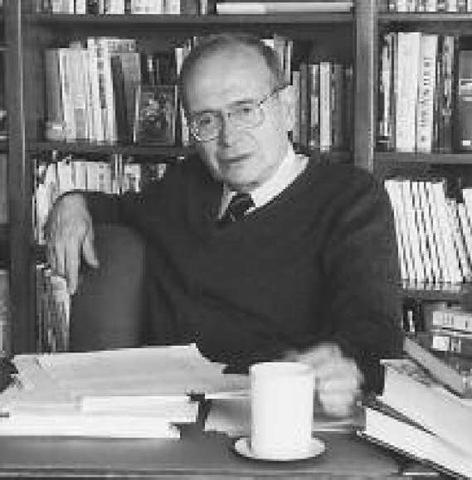(1924- ) American Geophysicist
Frank Press is one of the top five most influential Earth scientists of the 20th century. His research area is seismology both in terms of generation (earthquakes) and wave travel but also in terms of the structure of the Earth that it reveals. He was the first to investigate long-period surface waves and free oscillations (two types of seismic waves) as deep probes of the Earth’s architecture. During the time he worked with beno gutenberg, he developed new more sensitive instrumentation and recording devices for better resolution of the wave arrivals. The data he collected using these new instruments allowed Press to better define the layers within the Earth from the crust to the deep mantle. He produced detailed profiles that show how seismic velocity changes with depth in the Earth. The basic layers were subdivided and their character better defined at accurate depths. This new level of scientific research defined the beginning of modern geophysics. It also contributed significantly to the understanding of plate tectonics. The new instrumentation allowed him to record events not only on the Earth but also on the Moon and other planets. Through these studies he was able to define the architecture of these extraterrestrial bodies as well.
Not only did his pioneering advances in seismology aid the science of geology, Frank Press was also of great public service. He is especially well known for his international coordination of the exploration of the ocean basins and the continent of Antarctica. The new instrumentation was of great use in monitoring earthquakes. He led several international projects to better monitor earthquakes on a worldwide basis and to formulate plans for better earthquake prediction. This new worldwide network with his new more sensitive instrumentation allowed Press to better monitor nuclear testing on a worldwide basis. He was called into service to help interpret any test that took place. Frank Press was called to the highest level of public service with membership on the science advisory panel to several presidents of the United States and participating sensitive negotiations on nuclear test bans and monitoring. These high-profile positions led Press to be named the “California Scientist of the Year” in 1960 and later as one of the top 100 most important people under the age of 40 in the United States by Life magazine in 1962.
Frank Press was born on December 4, 1924, in Brooklyn, New York, where he grew up. He attended the City College of New York and earned a bachelor of science degree in physics in 1944. He completed his graduate studies at Columbia University, New York, where he earned a master of arts in 1946 and a Ph.D. in 1949, both in geo-physics. Frank Press married Billie Kallick in 1946; they have two children. He joined the faculty at Columbia University upon graduation where he worked with w. maurice ewing. In 1955, he accepted a position at the California Institute of Technology in Pasadena where he became director of the Seismological Laboratory in 1957. In 1965, Press moved again to the Massachusetts Institute of Technology in Cambridge, where he assumed the responsibility of department chairman. During this time, Press served as a member of the science advisory committee to both President Kennedy and President Johnson. In 1977, Frank Press was called to Washington, D.C., to serve as science adviser to President Jimmy Carter, as the director of the Office of Science and Technology Policy. He was also the president of the National Academy of the Sciences, a position he held until 1994. He returned to serve as chairman of the department at Massachusetts Institute of Technology from 1980-1982. In 1994, Press became the Cecil and Ida Green Senior Fellow at the Carnegie Institution of Washington, D.C. In 1996, he became a partner in the Washington Advisory Group. In addition to being a great scientist and advocate, Frank Press is a skilled sailor and an authority on baseball and New Orleans-style jazz.
Frank Press in his office in Washington, D.C.
In spite of all of his effort devoted to advisory work, Frank Press has led a very productive scientific career. He is an author of more than 170 articles in international journals and professional volumes. Many of these are benchmark studies that are published in the most prestigious of journals. He is also an author of numerous books including Earth, probably the most complete textbook on physical geology, and Understanding Earth, probably one of the most popular textbooks on physical geology. The honors and awards that Frank Press has received for both his scientific contributions and advisory work are too numerous to list completely here. He received the National Medal of Science from President Clinton in 1994. He also received the Decorated Cross of Merit from Germany and the Legion of Honor from France. He was awarded numerous honorary doctoral degrees and numerous society awards, including the Arthur L. Day Medal from the Geological Society of America, the Bowie Medal from the American Geophysical Union, the Ewing Medal from the Society of Exploration Geophysicists, the Gold Medal from the Royal Astronomical Society of England, and public service awards from both NASA and the U.S. Department of the Interior. He even had Mt. Press in Antarctica named after him.
The service that Frank Press has performed to the profession and the public is even more astonishing than his awards. In addition to that described above, he served as an adviser to the U.S. Navy, U.S. Geological Survey, NASA, U.S. Department of Defense, U.S. Arms Control and Disarmament Agency, and the governor of the state of California. He served on the U.S. Nuclear Test Ban Delegation, the UNESCO Technical Assistance Mission, and the U.N. Conference on Science and Technology for Underdeveloped Nations. He served as president of the American Geophysical Union (1974-1976) and president (1962) and vice president (1959-1961) of the Seismological Society of America, among numerous other committees and panels.

